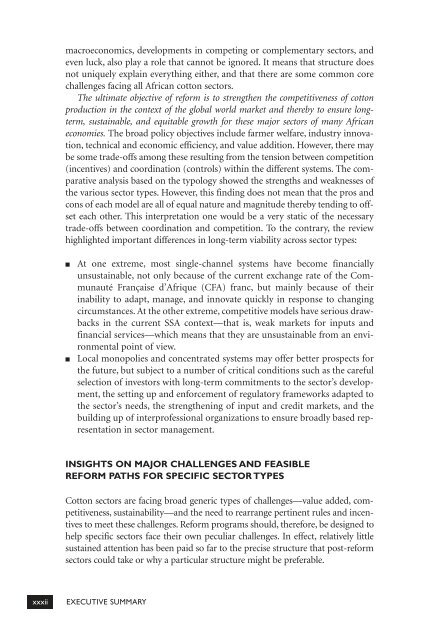Organization and Performance of Cotton Sectors in Africa ... - infoDev
Organization and Performance of Cotton Sectors in Africa ... - infoDev
Organization and Performance of Cotton Sectors in Africa ... - infoDev
You also want an ePaper? Increase the reach of your titles
YUMPU automatically turns print PDFs into web optimized ePapers that Google loves.
macroeconomics, developments <strong>in</strong> compet<strong>in</strong>g or complementary sectors, <strong>and</strong>even luck, also play a role that cannot be ignored. It means that structure doesnot uniquely expla<strong>in</strong> everyth<strong>in</strong>g either, <strong>and</strong> that there are some common corechallenges fac<strong>in</strong>g all <strong>Africa</strong>n cotton sectors.The ultimate objective <strong>of</strong> reform is to strengthen the competitiveness <strong>of</strong> cottonproduction <strong>in</strong> the context <strong>of</strong> the global world market <strong>and</strong> thereby to ensure longterm,susta<strong>in</strong>able, <strong>and</strong> equitable growth for these major sectors <strong>of</strong> many <strong>Africa</strong>neconomies. The broad policy objectives <strong>in</strong>clude farmer welfare, <strong>in</strong>dustry <strong>in</strong>novation,technical <strong>and</strong> economic efficiency, <strong>and</strong> value addition. However, there maybe some trade-<strong>of</strong>fs among these result<strong>in</strong>g from the tension between competition(<strong>in</strong>centives) <strong>and</strong> coord<strong>in</strong>ation (controls) with<strong>in</strong> the different systems. The comparativeanalysis based on the typology showed the strengths <strong>and</strong> weaknesses <strong>of</strong>the various sector types. However, this f<strong>in</strong>d<strong>in</strong>g does not mean that the pros <strong>and</strong>cons <strong>of</strong> each model are all <strong>of</strong> equal nature <strong>and</strong> magnitude thereby tend<strong>in</strong>g to <strong>of</strong>fseteach other. This <strong>in</strong>terpretation one would be a very static <strong>of</strong> the necessarytrade-<strong>of</strong>fs between coord<strong>in</strong>ation <strong>and</strong> competition. To the contrary, the reviewhighlighted important differences <strong>in</strong> long-term viability across sector types:■■At one extreme, most s<strong>in</strong>gle-channel systems have become f<strong>in</strong>anciallyunsusta<strong>in</strong>able, not only because <strong>of</strong> the current exchange rate <strong>of</strong> the CommunautéFrançaise d’Afrique (CFA) franc, but ma<strong>in</strong>ly because <strong>of</strong> their<strong>in</strong>ability to adapt, manage, <strong>and</strong> <strong>in</strong>novate quickly <strong>in</strong> response to chang<strong>in</strong>gcircumstances. At the other extreme, competitive models have serious drawbacks<strong>in</strong> the current SSA context—that is, weak markets for <strong>in</strong>puts <strong>and</strong>f<strong>in</strong>ancial services—which means that they are unsusta<strong>in</strong>able from an environmentalpo<strong>in</strong>t <strong>of</strong> view.Local monopolies <strong>and</strong> concentrated systems may <strong>of</strong>fer better prospects forthe future, but subject to a number <strong>of</strong> critical conditions such as the carefulselection <strong>of</strong> <strong>in</strong>vestors with long-term commitments to the sector’s development,the sett<strong>in</strong>g up <strong>and</strong> enforcement <strong>of</strong> regulatory frameworks adapted tothe sector’s needs, the strengthen<strong>in</strong>g <strong>of</strong> <strong>in</strong>put <strong>and</strong> credit markets, <strong>and</strong> thebuild<strong>in</strong>g up <strong>of</strong> <strong>in</strong>terpr<strong>of</strong>essional organizations to ensure broadly based representation<strong>in</strong> sector management.INSIGHTS ON MAJOR CHALLENGES AND FEASIBLEREFORM PATHS FOR SPECIFIC SECTOR TYPES<strong>Cotton</strong> sectors are fac<strong>in</strong>g broad generic types <strong>of</strong> challenges—value added, competitiveness,susta<strong>in</strong>ability—<strong>and</strong> the need to rearrange pert<strong>in</strong>ent rules <strong>and</strong> <strong>in</strong>centivesto meet these challenges. Reform programs should, therefore, be designed tohelp specific sectors face their own peculiar challenges. In effect, relatively littlesusta<strong>in</strong>ed attention has been paid so far to the precise structure that post-reformsectors could take or why a particular structure might be preferable.xxxiiEXECUTIVE SUMMARY
















